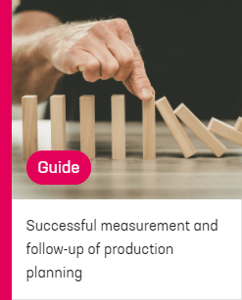 Measuring the efficiency of production planning is a long-term job, but fortunately also a rewarding one. Production planning is a key business function in manufacturing companies, acting as a gatekeeper to streamlined production that is in line with the company’s overall strategy. Therefore, it is also worth investing in monitoring of planning clear work and building indicators that focus on the core issues of the organization and the industry.
Measuring the efficiency of production planning is a long-term job, but fortunately also a rewarding one. Production planning is a key business function in manufacturing companies, acting as a gatekeeper to streamlined production that is in line with the company’s overall strategy. Therefore, it is also worth investing in monitoring of planning clear work and building indicators that focus on the core issues of the organization and the industry.
Why does production planning often go unmeasured?
Despite its central role, production planning is surprisingly often not systematically monitored in manufacturing companies. There are certainly many reasons for this. Factors influencing planning work can be perceived as difficult to identify, the company lacks the tools needed for monitoring, there does not seem to be enough resources for systematic measurement, or planning work is not sufficiently linked to business objectives.
→ Read more: What are the basic components of good production planning?
It is worth making a conscious effort to overcome these obstacles, as effective production planning helps optimize the use of human and machine resources, improve security of supply, optimize stock balances and committed capital, and in many ways shift the focus from reaction to prediction.
In order to systematically monitor the success of production planning, it is necessary to set indicators that bring out the core issues – a few well-considered ones rather than a large number of half-hearted ones. Key performance indicators vary depending on the sector and the company, but certain starting points are common to all.
How to build an effective production planning dashboard?
1. Give the indicator a descriptive name
Optimally, the name of the indicator describes directly and briefly what it is tracking.
2. Link the indicator to business objectives
As measurement is not done for its own sake, but with a purposeful focus on the strategic objectives of the business, this link should be clearly defined and recorded.
3. Choose a realistic level of monitoring
Success stories in measurement often start at the top level, because metrics depend on long-term data. Choose an indicator that provides the data you need in a way that is realistically available and of a reliable quality. The level of monitoring can be refined over time.
4. Define clear calculation formulae
Define production planning metrics so that calculation formulas are consistent, they are backed by a sufficient amount of data, and the calculation is possible without human intervention. The measurement should not be left to one person.
5. Choose the right level of monitoring
Success stories in measurement often start at the top level, because metrics depend on long-term data. Secondly, it is important to understand who the indicator is intended for, and the context in which it is used – for example, indicators for production managers and those for manual workers typically differ. Choose the indicator so that the necessary data are realistically available, and monitoring serves the organization’s desired target group.
6. Make a list of the necessary initial data
The initial data required for the indicator should be written down in a clear and practical way, so that it is as easy and routine as possible to obtain, regardless of the person.
7. Assign the responsible person(s)
As in many cases, things get done easier when a person is in charge of a specific task. The person in charge of a particular indicator can either be responsible for measuring and reporting on it, or he or she can act as a kind of supervisor or reminder. The main thing is that the measurement is done on time.
8. Remember continuous development
Although measurement is mainly based on past and present data, it is very much a forward-looking activity. The indicators help see trajectories, and improve the areas where improvements are needed.
The development of the indicator itself should not be forgotten either, but it is worth considering at regular intervals whether the indicator still answers the desired questions, or whether it needs to be refined or redirected. Business development work is never finished.
Have you become interested?
Download our guide Successful measurement and follow-up of production planning. In this guide, we consider why production planning is often left unmeasured, and we present typical metrics that can be used to monitor the success of production planning.

Read more:
Blog: Why is production planning more efficient with APS than ERP or Excel?
Success story Metsä Fibre: Add precision and transparency to production planning with PES
iPES by Pinja - Production planning and supply chain management system

Juho Arkkola
I’m a Head of Sales at Pinja, and I’m responsible for the sales of production development products. I enjoy working in different places so I travel around Finland and sometimes abroad in factories on different industrial sectors. This job allows me to see top Finnish industries from a front row seat.
Back to the Pinja Blog
Categories
- Pinja Career (70)
- Production development (43)
- Software development (43)
- Business Intelligence (42)
- Sustainability (31)
- Digital business (30)
- Circular economy and natural resources (27)
- Ecommerce (23)
- Supply chain management (23)
- ICT services (22)
- Maintenance development (22)
- Digital society (20)
- Industrial digitalization (20)
- ERP (18)
- Forest industry ERP (14)
- Industrial innovation (11)
- Health and welfare technology (9)
- Artificial intelligence and machine learning (7)
- Lean (4)
- eudr (1)